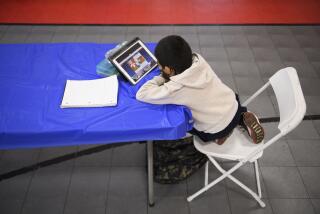Rabbit ears make comeback in digital TV era
- Share via
On a recent winter night, while neighbors strung their Baldwin Park homes with Christmas lights, the Lams and their three children sat in front of a television set with rabbit ears sprouting out of the top.
Wait a second -- rabbit ears? Is this 1950?
No, it’s almost 2010, and the Lams are a modern Los Angeles family that, like many in the region, are rediscovering the convenience -- and economics -- of the old-fashioned TV antenna.
In the wake of the transition to digital television, Southland viewers are finding they can get nearly three times as many channels as they once could with an antenna. And rather than the erratic, fuzzy reception of yesteryear, today’s rabbit ears are capable of delivering a surprisingly clear high-definition picture.
Best of all, it’s free, said Nancy Lam, the mother of the family.
“I’ve saved a lot of money by getting rid of cable,” Lam said. “We only had to purchase the antenna one time, and now we have it forever, instead of paying every single month.”
In these penny-pinching times, watching TV over the airwaves is becoming an increasingly attractive option for many households, particularly among the Los Angeles region’s minority communities.
Although the number of households with antennas in the U.S. fell slightly in the last year, nearly 20,000 Asian American homes in the region began using rabbit ears, and 8,000 African Americans switched to over-the-air TV, according to the media research firm Nielsen Co.
Nearly a quarter of Latino households with televisions, or about 440,000 homes, already tune in with an antenna -- the most of any demographic group in the area.
About 11% of U.S. households -- or about 13 million homes -- watch over-the-air broadcasts.
But watching TV over the airwaves has begun to appeal to a broader audience.
“It’s the best-kept secret around here,” said Mike Mahan, who recently installed a pair of antennas in the attic of his Ladera Ranch home and dropped his cable subscription. “I just got tired of paying for hundreds of channels I don’t watch.”
With antennas that can cost as little as a dollar, most Los Angeles viewers can now pick up close to 70 channels, up from around 26 before the federally mandated digital switch-over last summer. Nearly a dozen of the digital channels are broadcast in high definition.
Having upgraded to the more sophisticated digital technology, stations are able to slice their broadcast spectrum into a number of subchannels, such as KNBC-TV Channel 4’s 4.1, 4.2 and 4.4.
Many of the new channels are aimed at the region’s ethnic communities, giving rise to a growing selection of news, entertainment and educational programming for Latino, Asian and Eastern European viewers.
In Los Angeles, more than 30 over-the-air channels are available in English, including stations featuring movies, dramas and children’s programs. Major networks including ABC, CBS and NBC beam out daytime and prime-time shows -- and professional sports -- in resolution with clarity that may shock viewers expecting the hazy broadcast signals they remember from childhood.
“Everyone who does it says the picture quality is actually better than what you’re getting through cable,” said Patricia McDonough, a senior vice president at Nielsen.
As more viewers tune in to the newly reenergized possibilities of broadcast television, manufacturers say they can’t make antennas fast enough.
“Our sales are going through the roof,” said Richard Schneider, president of Antennas Direct, a St. Louis manufacturer of the devices.
Schneider said that sales had nearly tripled since the switch-over, and that he had to add a new assembly line in his factory to meet the demand. The company produces nearly 100,000 antennas every month, thousands of which are sold in the Los Angeles area, he said.
Viewers are also finding they can combine broadcast television with the growing array of movie and TV programming available online.
Mahan of Ladera Ranch dropped his subscription to Cox Cable last year in favor of a pair of high-end antennas and an Internet connection that lets him watch movies through Netflix and TV shows through video websites such as Hulu .com. He even rigged up a device that can record shows directly off the antenna.
But cable companies contend that over-the-air broadcasts are less reliable and that the signal can be easily interrupted or weakened, depending on where a home is. Homes near hills, for instance, may have trouble receiving all the channels available in a given area.
“There are always risks involved with going over the air or using an antenna to receive a digital picture, mainly because digital airwaves are not as forgiving as analog airwaves and are always subject to interference,” said Darryl Ryan, a spokesman for Time Warner Cable Inc.
In addition, many popular cable-only channels, including ESPN and CNN, are not yet available over the air. However, at least one Silicon Valley start-up has been experimenting with piping cable and satellite programs onto the airwaves in Los Angeles. Sezmi Corp. expects to roll out its service in major U.S. markets early next year. It plans to charge users about $25 a month for a service that offers a selection of broadcast, cable and Internet programming.
To watch broadcast TV, viewers must have both an antenna and a television capable of processing the digital signal. Those with pre-digital televisions can purchase a converter box for $30 to $50 that will enable the antenna to work with their TV set.
The cost of antennas varies according to their size and complexity, and can range from less than $5 for small, indoor rabbit ears to nearly $200 for a larger outdoor antenna that will receive more channels and clearer signals. Finding the right antenna, and the best location for it, may involve some trial and error.
The best evidence that the broadcast audience is growing may be the flowering of new local channels, said Francis X. Wilkinson, general manager of KJLA-TV, an L.A. station.
KJLA has divided its broadcast spectrum into nine digital sub-channels, 57.1-57.9. It carries three channels in Spanish, three in Vietnamese, and one each in Korean and Armenian. (The remaining sub-channel is a shopping network devoted to jewelry.) As with other broadcast stations, several of KJLA’s sub-channels are available via an antenna but not through cable.
“Nobody really expected the plethora of stations and choices that people would have over the air,” Wilkinson said. “It’s been a tremendous plus for everyone.”
In February, the Lams plan to watch local Chinese New Year festivities on Little Saigon TV (Channel 44.4). With their two swimmer sons practicing for the Junior Olympics and a daughter headed for college, the Lams haven’t had as much family TV time as they once did.
But when they do gather to watch the festivities, they’ll be using rabbit ears that don’t look any different from what viewers may have used six decades earlier, perhaps even in price. Instead of shelling out $30 for a new antenna, the Lams got theirs at a 99-cents store.
“The cheapest one was super clear,” Lam said.
More to Read
Inside the business of entertainment
The Wide Shot brings you news, analysis and insights on everything from streaming wars to production — and what it all means for the future.
You may occasionally receive promotional content from the Los Angeles Times.










